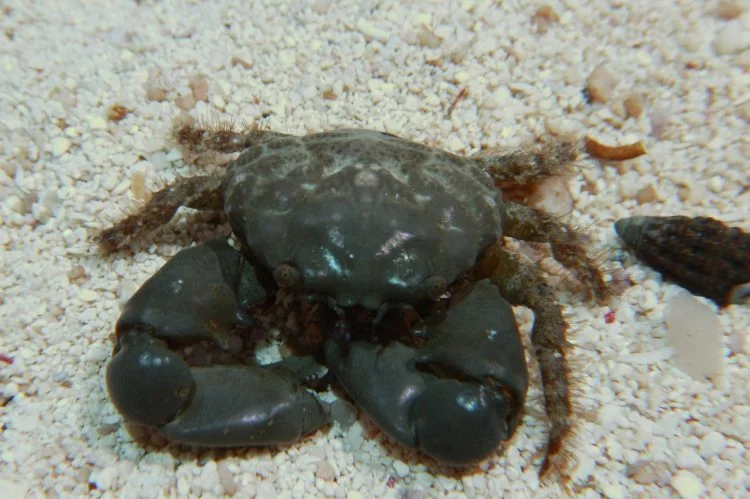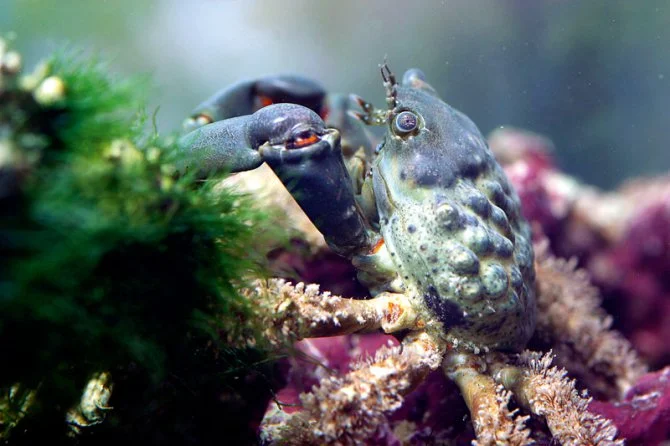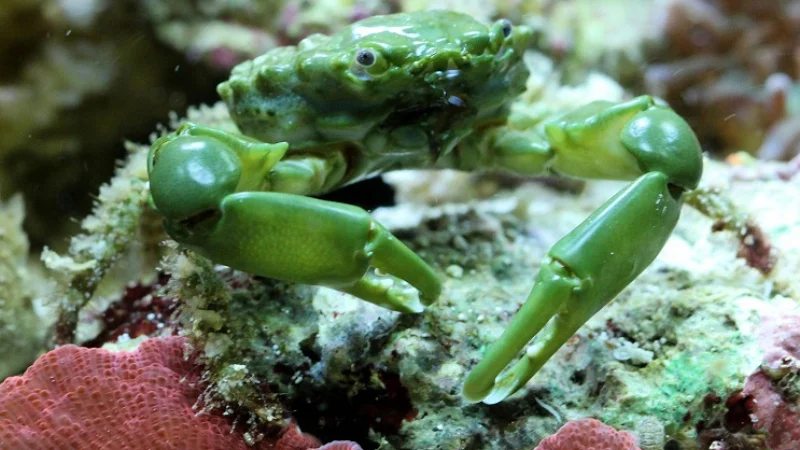Emerald crab max size is a topic of discussion among many hobbyists. It’s easy to see why emerald crabs are so famous; they’re cute and colorful! Emerald crabs have been known to grow up to an inch in length, but there is much variation between individual emerald crabs.
This blog post will discuss the emerald crab max size and tips for keeping your emerald crabs happy!
See also:
The Emerald Crab
The hue of the emerald crab inspired its name. All of the specimens possess a rich green color. There may be some white patches on the carapace and claws, but the crab is primarily green.
They also have a distinct form. The body is more comprehensive than long, and the carapace is flat (this allows to crawl underneath rocks to find shelter). The top of the shell, on the other hand, has a naturally rough texture.
The crab’s legs are slender and long. The back legs are hairy, whereas the front claws are big and sleek. The crab’s claws are similarly spoon-shaped, which aids in algae consumption.
Are Emerald Crabs Reef Safe?
Debatable! Many individuals, including myself, have had positive encounters with these tiny fellas. As of this writing, I have four of the 180 reefs. They usually perform well in a well-established tank that is well-fed. Hunger will transform these tiny fellas from Bruce Banner into the Hulk in shallow nutrition tanks with no algae to speak of and scant feeding. Many horror myths have their roots here.

What Do Emerald Crabs Eat?
Emeralds are omnivorous opportunists. They obtain their nutrition primarily from algae. They have been observed devouring bubbles and hair algae. However, this should not be regarded as a treatment for an outbreak. They’ve been kept consuming various invertebrates, coral polyps, and even tiny fish. They usually do this when they are hungry or in the right place at the right time. Those who are hungry will eat. The opportunistic part comes into play here. Don’t be shocked if you find them munching on an upturned Margarita Snail or a little ill fish. Margaritas can’t flip themselves over when they fall off rocks, and most of your scavengers will eat dead fish.
Behavior & Temperament
Its surroundings heavily influence the behavior of an emerald crab. These crabs will not pay attention to other crabs in the aquarium if the conditions are favorable. They’ll remain to themselves while searching for food. Despite this, this species is fully capable of being hostile.
When other green crabs infringe on their area, they might become hostile. If the crab isn’t eating enough, it might steal tiny fish, snails, or other invertebrates to eat! Females are less aggressive than men. However, all emerald crabs can become agitated when housed in small aquariums with little food to eat.
Aside from their potential for aggressiveness, emerald crabs are fascinating to observe. As previously stated, these animals are primarily nocturnal in the beginning. As they become more comfortable, they will spend more and more time eating during the day.

Emerald Crab Max Size
The average emerald crab lifetime is two to four years. They aren’t the most long-lived invertebrates, but they can survive the cheapest cleaner shrimp. As is usually the case, there is no way to predict life expectancy. These crabs are at the mercy of their surroundings and the care you offer. Maintain the aquarium with respect and do your part to provide the crabs a nutritious food. Otherwise, crabs might live much shorter lives.
When completely developed, the typical green crab measures around two inches. However, when it comes to this species, there is a lot of variation in terms of size. You could come across tiny specimens that are less than 1.5 inches long or larger ones that are up to 2.5 inches long. The majority of this variation is due to genetics.
What Tank Size Is Recommended For The Emerald Crab?
There is no minimum tank size because the usual specimen is 12 – 1″ in length and the maximum size is approximately 2″ in base body diameter. It is more dependent on your other residents. You could keep one in a 2.5 – 5 gallon nano tank with live rock and a few coral frags. I wouldn’t put any other crabs in a tank that big since your emerald would most likely take it all as his empire. When raising several emerald crabs, a reasonable rule of thumb is 30 gallons per emerald crab, with enough rock work in those gallons for them to split around the tank. I have around 90 lbs. of rockwork in the arrangement section where the crabs are and five in my 180g tank.
FAQs
Can emerald crabs live together?
However, most Emerald Crabs are very tolerant of their tankmates and highly compatible in reef environments when well fed.
Will emerald crabs kill each other?
Emerald Crabs can be aggressive to each other. Therefore, if you have a small tank, it will be better to have only one crab or a pair of the opposite sex.
Do emerald crabs eat corals?
It’s an opportunistic omnivore that, in addition to grazing algae, will scavenge dead animals and may even attack and consume live ones—including coral polyps and small fishes.
Conclusion
When completely developed, the typical emerald crab size is approximately two inches, which is why you must select a truly adequate tank for emerald crab max size. We hope you found this helpful tutorial and feel better prepared to keep an emerald crab in your home tank!

Annette M. Chaney is an experienced marine biologist with over 20 years of experience as an aquarist and fishkeeper. She started her first aquarium at a young age, filling it with frogs and goldfish obtained from the ten-cent pet store.
Annette grew up caring for and breeding African Cichlids, which led to a hobby in high school that doubled as a profitable means. Attending Reed College gave her time to solidify herself as an accomplished aquarium caretaker with an eye for sales. After that, from 2009 – 2013, she studied at Roger Williams University – one of the most prestigious universities for Aquaculture and Aquarium in USA. She is the founder of AquariumCircle since 2010.
